| Middle Latest wheat production technology to take more than low cost production |
|
National and Regional Landscapes
| |
Area (M.O.) |
Production (Miteton) |
Productivity (Q/O) |
| India |
29.7 |
93.5 |
31.5 |
| Madhya Pradesh |
5.3 |
13.3 |
5.3 |
| Partners of the State |
18% |
14% |
18% |
|
| In the State Problems related to wheat productivity |
(a) related to undenatured/limited irrigation areas-
- The thermal average details of the last seven years are the following.
Increased temperature 2 – 30 seconds
High temperature rise 3 – 50 s
- Overtake in the summer for the first week of November – lows
- Lack of real high heat resistance varieties that can harmonize the changing surroundings
- High temperature at the time of germination and filling the grain
- Root Rot problem in undenatured areas
- Soybeans – Wheat Undenatured/Undenatured Wheats in Crop System The delay of sowing (the obsolete strands have long-term)
- Low "water use" of prevalent varieties and "nutrient use" capacity
(b) related areas of irrigation
- Rabi Season Slope Period Short Winter
- Uncertain Weather
- Increasing the temperature at the time of the harvest and at the time of pollination thereby maturity in premature harvest
- Results Format Less filler of granules
- Over-stortion of land due to high temperature thereby increasing the number of irrigation and the amount of irrigation water
- Unavailability of water for irrigation on time even in margin areas
- Seepage and water filler problems in irrigation areas
- More rake of sowing delayed due to multi crop system
|
| In the State Changed format of the installment of wheat |
(a) Excluded Rakba over the years
- Now a remarkable reduction in fully undenatured rakebe
- Cultivation in accumulated moisture (Conserved Moisture) virtually eliminated
- Sprinkler irrigation method revenge this scenario
- The use of at least one irrigation in almost the whole state. So the fully undenatured rakeba virtually eliminated
(b) Limited irrigation availability in actual appendages in the irrigation zone
- The term irrigated consists of 5-6 irrigation availability
- 5 – 6 Irrigation Unavailability across the state as real
- 3 irrigation availability in most sectors even in time-to-bowed wheat
- Only two irrigation availability in case of delayed sowing
|
| Production technology |
| Farm Preparation
· Summer
· Three years deep tilling
· Black Heavy Mud Broom (Fine Tilth) Making Hard
· Rotavator Use Suitable Disc Harrow Also Suitable Busy Time
· Assigned: from mid-October to the first week of Nov
· Refined: First Witch of November Month
· Sintered (From time): Second Pakhwada of November month
· Sintered (from Derry): from 2nd week of December |
| Selection of suitable varieties |
(a) Malwa Zone: Ratlam, Mandsaur, Indore, Ujjain, Shajapur, Rajgarh, Sihore, Base, Dewas and the southern part of the fold
Average rainfall of the area: 750 to 1250 mm
Soil: Heavy Black Mud
| Undenatured/Undenatured |
Sintered(From Time) |
Sintered (by Dairy) |
JW 17,
JW 3269,
JW 3288,
H.I. 1500
HI 1531,
HD 4672 (hard) |
JW 1201,
J.W. 322,
JW273,
HI 1544,
H.I. 8498 (hardened),
MPO 1215 |
JW 1203,
MP 4010,
HD 2864,
H.I. 1454 |
(b) Nimad Zone: Khandwa, Khargon, Dhar and Zubua Part
Average rainfall of the area: 500 to 1000 mm
Soil: Light Black Soil
| Undenatured/Undenatured |
Sintered(From Time) |
Sintered (by Dairy) |
JW 3020,
J.W. 3173,
H.I. 1500
JW 3269 |
JW 1142,
JW 1201,
G.W. 366,
H.I. 1418 |
Avoid sowing delays in this area. Preference to sowing from time to time because the lack of water at the time of ripening.
Varieties: JW 1202,
H.I. 1454 |
(c) Vindhya Platehar: Raisen, Vidisha, Sea, Part of Fold
Average rainfall of the area: 1120 to 1250 mm
Soil: Heavy black ground from the middle
| Undenatured/Undenatured |
Sintered(From Time) |
Sintered (by Dairy) |
JW 17,
J.W. 3173,
JW 3211,
JW 3288,
HI 1531,
H.I. 8627(Width) |
JW 1142,
JW 1201,
HI 1544,
G.W.273,
J.W. 1106 (hardened),
H.I. 8498 (hardened),
MPO 1215 (Kathi), |
JW 1202,
JW 1203,
MP 4010,
HD 2864,
DL 788-2 |
(d) Narmada Valley: Jabalpur, Narsinghpur, Hoshngabad, Harida
Average rainfall of the area: 1000 to 1500 mm
Soil: Heavy Black & Waterfall Soil
| Undenatured/Undenatured |
Sintered(From Time) |
Sintered (by Dairy) |
JW 17,
JW 3288,
HI 1531,
JW 3211,
HD 4672 (hard) |
JW 1142,
G.W. 322, J.W. 1201, H.I. 1544, J.W. 1106, H.I. 8498, J.W. 1215 |
JW 1202,
JW 1203,
MP 4010,
HD 2932, |
(i) Benganga Valley: Balaghat and Suenee
Average rainfall of the area: 1250mm
Soil: Waterfall Soil
| Undenatured/Undenatured |
Sintered(From Time) |
Sintered (by Dairy) |
JW 3269,
JW 3211,
JW 3288,
HI 1544, |
JW 1201,
G.W. 366,
HI 1544,
Secrets 3067 |
JW 1202,
HD 2932,
DL 788-2 |
(R) Haveli Area: Part of Reva, Jabalpur, Part of Narsinghpur
Average rainfall of the area: 1000 to 1375 mm
Soil: Light pebbled soil
Rain water is prevented in the field by licence.
| Undenatured/Undenatured |
Sintered(From Time) |
Sintered (by Dairy) |
JW 3020,
J.W. 3173,
JW 3269,
JW 17,
H.I. 1500 |
JW 1142,
JW 1201,
JW 1106,
G.W. 322,
HI 1544, |
JW 1202,
JW 1203,
HD 2864,
HD 2932, |
L. Satpura Platehar: Chhindwara and Baitul
Average rainfall of the area: 1000 to 1250 mm
Soil: Light pebbled soil
| Undenatured/Undenatured |
Sintered(From Time) |
Sintered (by Dairy) |
JW 17,
J.W. 3173,
JW 3211,
JW 3288,
HI 1531, |
HI 1418,
JW 1201,
JW 1215,
G.W. 366, |
HD 2864,
MP 4010,
JW 1202,
JW 1203, |
(v) Gird region: Gwalior, Bhind, Murena and Datiya part
Average rainfall of the area: 750 to 1000 mm
Soil: Grounds with aqueous and light structure
| Undenatured/Undenatured |
Sintered(From Time) |
Sintered (by Dairy) |
JW 3288,
JW 3211,
JW 17,
HI 1531,
JW 3269,
HD 4672 |
HI 1544,
G.W.273,
G.W. 322,
JW 1201,
JW 1106,
JW 1215,
HI 8498 |
MP 4010,
JW 1203,
HD 2932,
HD 2864 |
(h) Bundelkhand Region: Datiya, Shivapuri, part of the fold Tcomgarh, part of Chhatrapur and Emerald
Average rainfall of the area: 1120 to 1250 mm
Soil: Red & Black Mixed Ground
| Undenatured/Undenatured |
Sintered(From Time) |
Sintered (by Dairy) |
JW 3288,
JW 3211,
JW 17,
H.I. 1500
H.I. 153 |
JW 1201,
G.W. 366,
Raj 3067,
MPO 1215,
HI 8498 |
MP 4010,
HD 2864 |
|
| Special: Varieties in the condition of sowing with extreme delay in all areas: HD 2404, MP 1202 |
| GW 173
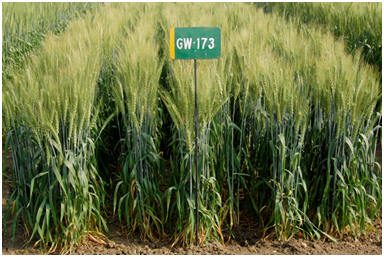
|
Public 1

|
MP 4010
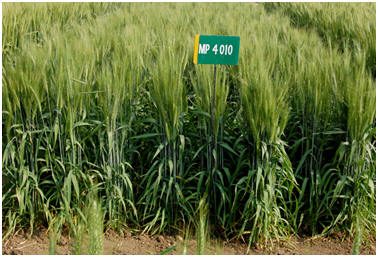
|
| MP 1202
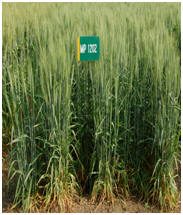
|
MP 1203

|
Hd 2864
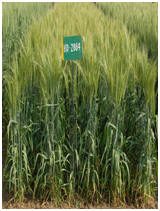
|
| Madhya Pradesh Agriculture Export Zone has been identified since the State Year 2003. |
| The state’s wheat production contributes to 8 to 10 per cent of the wooded varieties. |
|
| Advanced wood variety |
HD 8713 (Pusa Mars) ,HI 8381 (Malwashri) ,HI 8498 (Malwpower) ,HI 8663 (Nutrition),MPO 1106 (Suddha),MPO 1215,HD 4672(Malwarttan) ,HI 8627 (Malkyti)
| JW 3211
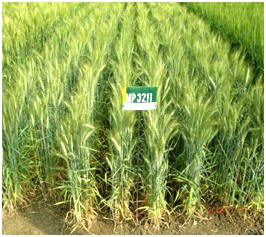
|
JW 3173
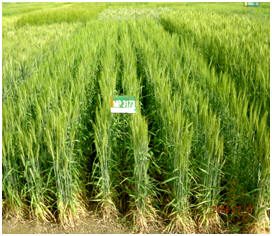
|
|
| Seed quantity |
| · Average 100 kg/h. (The weight of our granule is up to 40 grams)
· Weight of a thousand vine grows 1 g (up to 40 g), 2.5 kg per/h
· Distance from queue to queue in undenatured/semi-sized condition 25cm
· Sintered (From time to time) 23cm in case of sowing
· Do not mix seeds with fertilizer
· 32 per cent germination reduction (5 years of research statistics)
· Why wheat crop has the ability to keep indemnity at each stage when favorable weather.
· So use seed low fertilizer drill. |
| Seedlings |
| · Sow the seeds before sowing, carboxine 75% for seed treatment, wp/carbondizyme 50% wp 2.5-3.0 g is sufficient for drug/kg seed.
· Tebukonosal is prevented by the disease of the canopy when we get from 1 g/kg seed.
· PSB culture increases the availability of phosphorus when treated with 5 g/kg seeds. |
| Using nutrients |
| · Ensure Soil Testing
· Depending on the test, determination of the amount of traject, phosphate and potash is recommended –
· Reduction of micro elements in almost all districts in the state
· Use of Zinc Sulphate at a rate of 25 kg/h
· Use of zinc sulfate after 3 harvests (each year of new)
| |
English |
Phosphorus |
Potash |
| Featured |
40 |
20 |
0 kg/h |
| Featured |
60 |
30 |
15 kg/h |
| Featured |
120 |
60 |
30 kg/h |
| Delayed |
80 |
40 |
20 kg/h |
Irrigation –
- Use the sprinkler as far as possible
- 5 – 6 Irrigation Needs in New Varieties Developed from University
- 3 – 4 Irrigation Sufficient (55 – 60Quantal yield)
- Irrigation: 40 – 45 days after
- Two irrigation: Kirit stage, after flowering
- Three Irrigation: Kirit stage, on the whole lash, at the time of becoming Dana
- Four Irrigation: Kirit stage, when the whole buds are released, the milky state

|
| Cost reduction (new technology) |
|
Pore – Drain Designation
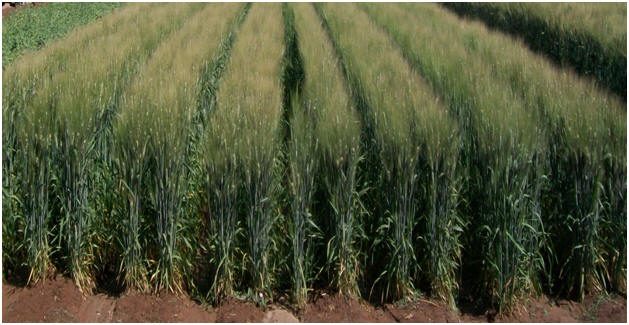
|
· To reduce the costly inputs in seeds and fertilizers, the seed rate can be reduced by 30 – 35 per cent.
· Reduction of fertilizer consumption
· Sleep Control Easy
· Low volume of water in irrigation |
| More Different Techniques of Wheat Production |
Zero Tillage Technique:-
After harvesting the harvest of the paddy harvest, the farm won’t save time for the sow of wheat in time and the farm, besides leaving the farm, the farmer won’t save the option. Made in a special form in such a condition Seeds and manure drill machine can be sowing wheat.
The method of direct sowing of wheat is called zero tillage by the machine without sowing after harvesting the farm which does not require tillage. By adopting this method, the damage that occurs when the wheat is late can be avoided and the cost of the farm may also be reduced on preparation.
This technique can be carried out in all types of lands in addition to smooth soil. Zero tillage machine is just like ordinary drill. It has tyn knife like This tines creates a crack of shape like a groove in the soil, allowing manure and seeds to reach appropriate volume and depth. This method has the following benefits. :-
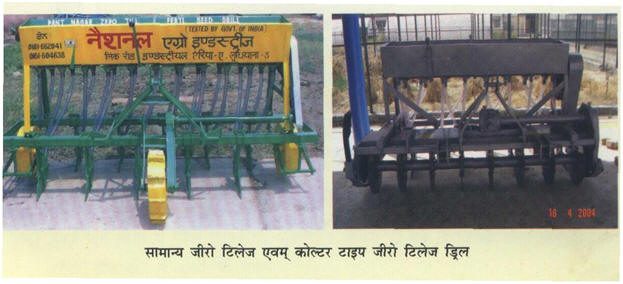
Benefits of Zero Tillage Techniques :-
· Sowing by this machine can save 85-90 percent of fuel, energy and time.
· The adoption of this method reduces the deposition of weeds.
· The sowing of 1-1.5 acres of land can be carried out in 1 hour by this machine This is a low energy consumption technique, so in the event of sowing from time to time, the cost of preparing the farm is Rs.2000-2500 per hectare.
· Sowing and sowing can be produced from time to time.
· Before starting sowing, make the machine cleared and put the appropriate amount of manure and seed.
· Just use the granular manure in this machine so as not to generate resistance in pipes.
· Never put the machine behind.
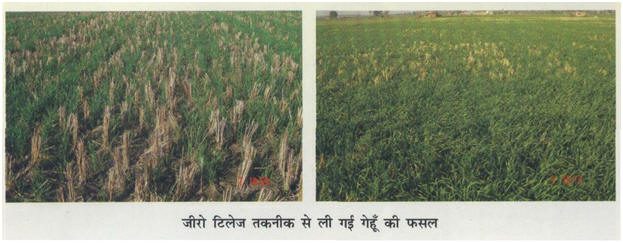
Sowing technique on the furo Irrigation Recessed Bed (Ferv):-
· The sowing technique on the merry varies by sowing or sprinkling the sorghum in farmers. In this technique, wheat sows seeds in two or three queues on the gums with a tractor running Roger less drill. This technique saves manure and seed. and production is not affected. High quality more seed can be produced from this technology.
Benefits of harvesting (Ferv) on the merch
· Reduces and saving of seed, manure and water content, moisture protected in the meds is available for a long period of harvest and the growth of plants is good.
· Wheat production cost reduction.
· Wheat is cultivated on drains and torso. This does not lead to cropping. Cropping on the med is good for growth of roots and roots absorb moisture and nutrients deeply.
· This method is used for irrigation in wheat production. The drains are also helpful in excess water extraction.
· Increases productivity of Dalhani and Tilhani crops.
· The machine can also be denounced.
· Ease of removing unwanted plants. |
| Global Excellence |
| · A century season is clear of statistics that temperatures in 2009 – 10 (lower) from 10 to high temperature 20 to high.
· Jawaharlal Nehru Agricultural University has the ability to produce even more on high heat developed by J.W. 1142, J.D.W. 1201, J.W. 3211 and J.W. 3288 varieties. |
| Water and Nutrient Use Capacity |
| · Crop affected by erosion in the land of constant irrigation water and lack of irrigation water
· Developed varieties with more "water utilization potential" and "nutrient use capacity"
| Variety |
Phase (Subscribe Quintal/O) |
| Featured |
An Irrigation |
Two Irrigation |
| JW 17 |
18-20 |
30-32 |
– |
| JW 3020 |
18-20 |
32-34 |
40-42 |
| JW 3173 |
18-20 |
34-36 |
40-42 |
| JW 3211 |
18-20 |
37-39 |
43-45 |
| JW 3269 |
18-20 |
37-39 |
43-45 |
|
| The outbreak of the new distinction of Black GerruaUG 99) |
| · Madhya Pradesh Most Favorable for the outbreak of Black Gerrua
· Control due to the development of anti-gerosion varieties
These varieties of MPO1215, MP3336, MP4010 varieties developed by Jawaharlal Nehru Agricultural University were tested in "Kinnia". All varieties have the ability to produce resistant and more of vortex 99.
|
| Compilation of properties (Value Addition |
| · The weight of the best donations in quality in the country of wheat.
· The amount of protein than the second states 1 percent higher
· yet attempted to increase the amount of protein
· The currently developed varieties are rich in microelements.
· Varieties developed from the University J.W. 1202 and J.W. 1203, the most protein than other varieties developed in the country
· The most "vitamin A" in currently university developed varieties
· Most Iron, Zinc and Magnesium |
| Quality mandate in varieties developed by J.V. |
| Trent |
Variety |
| J.W.1201 |
J.W.1203 |
G.W. 173 |
D.L. 788-2 |
MP4010 |
| Protein percent |
12.64 |
13.50 |
12.20 |
12.4 |
12.43 |
| Sedimentation Value |
43 |
38 |
38 |
40 |
41 |
| Extension Rate |
70.6 |
70.9 |
70.4 |
69.5 |
69.9 |
| Gluten Index |
63 |
52 |
51 |
56 |
48 |
| B – Carotene |
3.10 |
3.77 |
2.19 |
2.61 |
2.81 |
| Iron (PPM) |
42.2 |
33.9 |
37.0 |
37.1 |
40.5 |
| Zinc (PPM) |
41.9 |
35.3 |
33.9 |
33.6 |
34.4 |
| Manganese (PMM) |
51.9 |
49.7 |
41.3 |
50.8 |
43.5 |
|
| Positive side of M.P. |
| · Reduction in undenatured area
· Increased irrigation facilities
· Use of the sprinkler method
· Increased fertilizer consumption
· Enhance the use of micro elements too
· Speed and availability of new varieties Satisfactory
· अच्छी गुणवत्ता के बीजों की उपलब्धता
· उदाहरण के रूप में विश्वविद्यालय ‘‘बीज उत्पादन‘‘ में देश में प्रथम
· कठिया गेहूँ में ‘‘करनाल बन्ट, यलोबेरी, कालाधब्बा‘‘ आदि के प्रकोप से मुक्त
· अतः निर्यात की सम्भावना बढ़ी |
| खरपतवार नियंत्राण |
खरपतवारों द्वारा 25-35 प्रतिशत तक उपज में कमी आने की संभावना बनी रहती है। यह कमी फसल में खरपतवारों की सघनता पर निर्भर करती है उत्पादन में कमी के अलावा फसल को दिये गये पोषक तत्व, जल, प्रकाश एवं स्थान आदि का उपयोग खरपतवार के पौधों के स्वयं के द्वारा करने के कारण होती है गेहूँ में नीदाँ नियंत्रण उपायों को मुख्यतः तीन विधियों से किया जा सकता है।
गेहूँ की फसल में होने वाले खरपतवार मुख्यतः दो भागों में बांटे जाते है।
- चौड़ी पत्ती – बथुआ, सेंजी, दूधी, कासनी, जंगली पालक अकरी, जंगली मटर, कृष्णनील, सत्यानाषी हिरनखुरी आदि।
- सकरी पत्ती – मोथा, कांस, जंगली जई, चिरैया बाजरा एवं अन्य घासें।
|
| रासायनिक विधि:- |
| रासायनिक विधि से नींदा तक को प्राथमिकता दी जाती है क्योंकि इससे समय की बचत होती है। रूप से भी लाभप्रद रहता है। इस विधि से नींदा नियंत्रण निम्न प्रकार करते हैं –
नींदनाशक रसायनों की मात्रा एवं प्रयोग समय:-
| नींदानाशक |
Weed |
Rate |
प्रयोग का समय |
| पेण्डीमिथेलीन |
संकरी एवं चौड़ी |
1.0 किग्रा. |
बुवाई के तुरन्त बाद |
| सल्फोसल्फूरान |
संकरी एवं चौड़ी |
33.5 ग्रा. |
बुवाई के 35 दिन तक |
| मेट्रीब्यूजिन |
संकरी एवं चौड़ी |
250 ग्रा. |
बुवाई के 35 दिन तक |
| 2, 4 – डी |
चौड़ी पत्तिया |
0.4 – 0.5 किग्रा. |
बुवाई के 35 दिन तक |
| आइसोप्रोपयूरान |
संकर पत्तिया |
750 ग्रा. |
बुवाई के 20 दिन तक |
| आइसोप्रोपयूरान +2, 4 – डी |
चौड़ी पत्तिया एवं संकरी पत्तिया |
750 ग्रा +750 ग्रा. |
बुवाई के 35 दिन तक |
|
| गेहूँ के विपुल उत्पादन के लिए मुख्य आवश्यक बातें:- |
· मिट्टी की जांच के बाद उर्वरकों को प्रयोग करें। संतुलित मात्रा में समय पर उर्वरक दें। उर्वरकों का सही प्लेसमेंट उत्पादन बढ़ाने में एवं उर्वरक उपयोग क्षमता बढ़ाने में योगदान देता है। उर्वरको को बीज से 2-3 सेमी नीचे डाले। कार्बनिक एवं जैविक स्रोतों का भरपूर उपयोग करे जिससे मृदा स्वास्थ्य एवं उत्पादकता बढ़ती है।
- बीजदर अनुशंसित मात्रा में उपयोग करे। क्षेत्र विशेष के अनुसार शुद्ध, स्वस्थ्य, कीट एवं रोग रोधी किस्मों का चयन करें। समय पर बोनी करे। बीज एवं खाद एक साथ मिलाकर बोनी न करें। देर से बुवाई की अवस्था में संसाधन प्रबंधन तकनीक जैसे, जीरो टिलेज का प्रयोग करें। यथासंभव बुवाई लाइनों में करें क्रासिंग न करें। पौध संख्या अनुशंसा से ज्यादा न करें।
- खरपतवार नियंत्रक उपाय समय पर करें। खरपतवारनाशी दवाओं का इस्तेमाल करते समय ध्यान दे कि फसल में नीदाओं की सघनता एवं नीदाओं के प्रकार के हिसाब से रसायन का चयन करें। खरपतवार नाशी दवा का उपयोग मृदा में पर्याप्त नमी होने की दशा में सही मात्रा एवं घोल का इस्तेमाल करें।
· गेहूँ में सिंचाई मिट्टी का प्रकार सिंचाई साधन, सिंचाई उपकरण को ध्यान में रखकर क्रान्तिक अवस्थाओं पर सिंचाई देवे।
- कीट एवं रोग नियंत्रक उपाय समय पर करें।
· गेहूँ फसल की कटाई उपरांत नरवई खेतों में न जलायें, नरवई जलाने से खेतों की मृदा में उपलब्ध लाभदायक सूक्ष्म जीवाणुओं का ह्रास होता हैं नरवई की आग से लोगों के घरों में भी आग लगती है। एवं जन व पशुधन हानि की भी संभावना रहती है। गेहूँ की फसल कटाई उपरांत खेतों में समुचित नमी की दशा में रोटावेटर चलाने से नरवई कटकर मिट्टी में मिल जाती है जो कि मृदा के लिए लाभदायक भी है।
· आज के समय में रसायनों के असंयमित प्रयोग से खेती की उत्पादन लागत बढ़ रही है। आवश्यकता है कि इस उत्पादन लागत को कम किया जाये। उत्पादन लागत को कम करने का सस्ता एवं प्रभावी तरीका है समन्वित प्रबंधन उपायों को अपनाना।
· मौसम के परिवर्तन, ग्लोबल वार्मिंग के कारण धरती के बढ़ते तापमान एवं अनिश्चितता के कारण दिन प्रतिदिन कीड़े एवं बीमारियों की समस्या फसलों में बढ़ रही है। इनके प्रभावी प्रबंधन हेतु समन्वित उपायों को अपनाना नितांत आवश्यक है।
· खेती में उत्पादन प्राप्त करने के लिये समय पर कुशल प्रबंधन एवं सही निर्णय आवश्यक है कई बार किसान भाई खरपतवार नियंत्रक उपायों को देर से अपनाते हैं जिसके कारण खरपतवार फसल की क्रांतिक अवस्था निकल जाती है एवं खरपतवार के पौधे मजबूत हो जाते हैं फिर उनका नियंत्रण रसायनों से भी मुश्किल होता है। |

